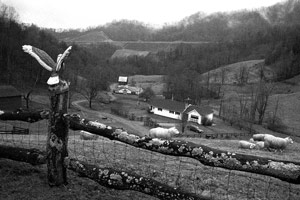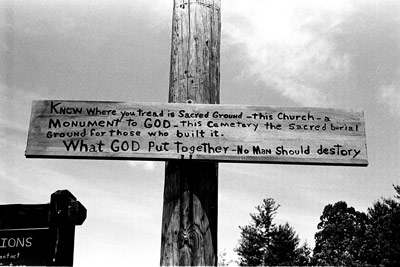When photojournalist Rob Amberg began work on his latest book, The New Road (The Center for American Places, 2009), he admits that he was "pretty decidedly against" the nine-mile section of I-26 that recently paved a swath through rural Madison County. And the photos, prose and interviews Amberg captured do detail the destruction in the wake of that project, which was the state of North Carolina's most ambitious earth-moving to date. Families were moved off land they'd held for decades. A cemetery was exhumed and relocated, a church razed and an apple orchard bulldozed.

But Road also tells another story. "Over time, talking to people — people who were working on the road, engineers and politicians, but also down-to-the-earth folks who were the ones really being impacted by the road — I began to realize that the immediate community was so solidly behind that road," says Amberg. He cites safety and economic benefits as the top pros.
In one profile, Madison County resident Harold Wallin says, "When you build this road through here, that will bring the people; they'll come right on outta here and backwards and forwards. At least it puts us on the map. My grandsons will sit right down here, I hope, and there's homes and over yonder is homes. All they'll have to do is put their feet up."
What Road showcases is the changing face of Appalachia, a phenomenon in which Amberg — who came to Marshall in 1973 — is well versed. His previous book, Sodom Laurel Album, is an intimate and sometimes startling look at the inhabitants of one remote mountain community. But as much as Sodom depicts a region cut off from the rest of the world, Road shows that same area as it becomes accessible. "Opening. That's the idea of a highway," Amberg remarks. He has already begun work on a third album, the completion of the trilogy, which focuses on Madison County's new demographic. "I think the population change we're seeing now is as significant as when white people took [the land] from the Indians," he says.
This shift is already evident in Road, where residents like Bill Clark, whose family were sharecroppers in the area, are juxtaposed with others like artist Faith Teel who posed for Amberg in costume at Marshall's first Mermaid Parade. But the old and new guards are not so disparate as they might seem: Both demonstrate a love for the land. Long-term resident Dale Fluty says in one narrative, that what he treasures about the mountains is "those old-timers who made their living here and loved the ground and loved the cattle and loved the mountains."
Iktome (a relative newcomer to Madison County; known to many in Asheville as Snakehawk) told Amberg, "From now on I'm gonna have this place where anybody that goes there is going to experience something I experienced. I thought: 'If I work with this, putting good energy onto this place, then I could make it where everybody that goes through this cut is going to be transformed in some way.'"

Amberg points out that inroads to the Appalachians are nothing new. "The route I-26 takes through Madison County has been a trade route since Native American times," he notes. "The history of the region is one of change in a lot of ways. The highway isn't the change, but it's accelerating the process."
But Road doesn't shun progress. In fact, Amberg finished the book — a collection of black and white photos including stunning images such as one of a DOT worker removing a king snake from a building site —with a final chapter done in digital color. "I did that symbolically to admit my own coming to technology," the photographer says.
The section of I-26 portrayed in Road was opened to traffic in 2003; the dreams and fears revealed in Amberg's book have come to pass. While Amberg realizes there's no turning back, he does hope that Road brings "a better understanding of the real cost of the highway. We as North Carolinians understand the dollar amount. We don't understand the other costs that don't get compensated: memory, wilderness."
While Amberg isn't suggesting the project was handled poorly, he does believe that, going forward, public planners could better take into account the needs of communities affected by such monumental projects. There are no easy answers, and the photographer seems comfortable in his ambivalence.
"I am often asked how I feel about the highway," he writes in Road. "My answers are pained as I struggle with loving it and hating it. I know it's here and being used. I've used it and can attest to its beauty, safety, and efficiency. But I remain conflicted, and questions persist."
Alli Marshall can be reached at amarshall@mountainx.com.
who: Rob Amberg
what: Photographer exhibits image from his forthcoming book, The New Road
where: Madison County Arts Council (56 N. Main St., Marshall)
when: Saturday, Nov. 7, 6-9 p.m.



Before you comment
The comments section is here to provide a platform for civil dialogue on the issues we face together as a local community. Xpress is committed to offering this platform for all voices, but when the tone of the discussion gets nasty or strays off topic, we believe many people choose not to participate. Xpress editors are determined to moderate comments to ensure a constructive interchange is maintained. All comments judged not to be in keeping with the spirit of civil discourse will be removed and repeat violators will be banned. See here for our terms of service. Thank you for being part of this effort to promote respectful discussion.